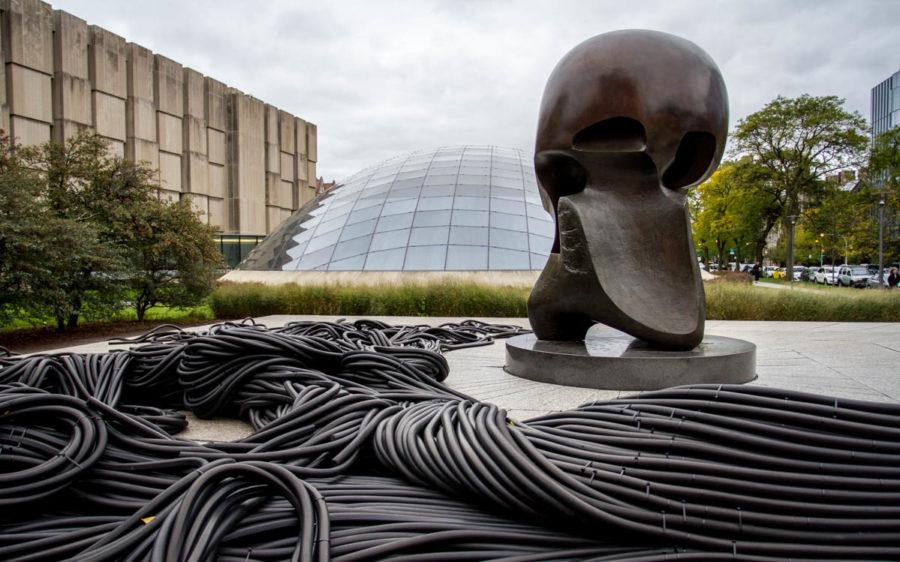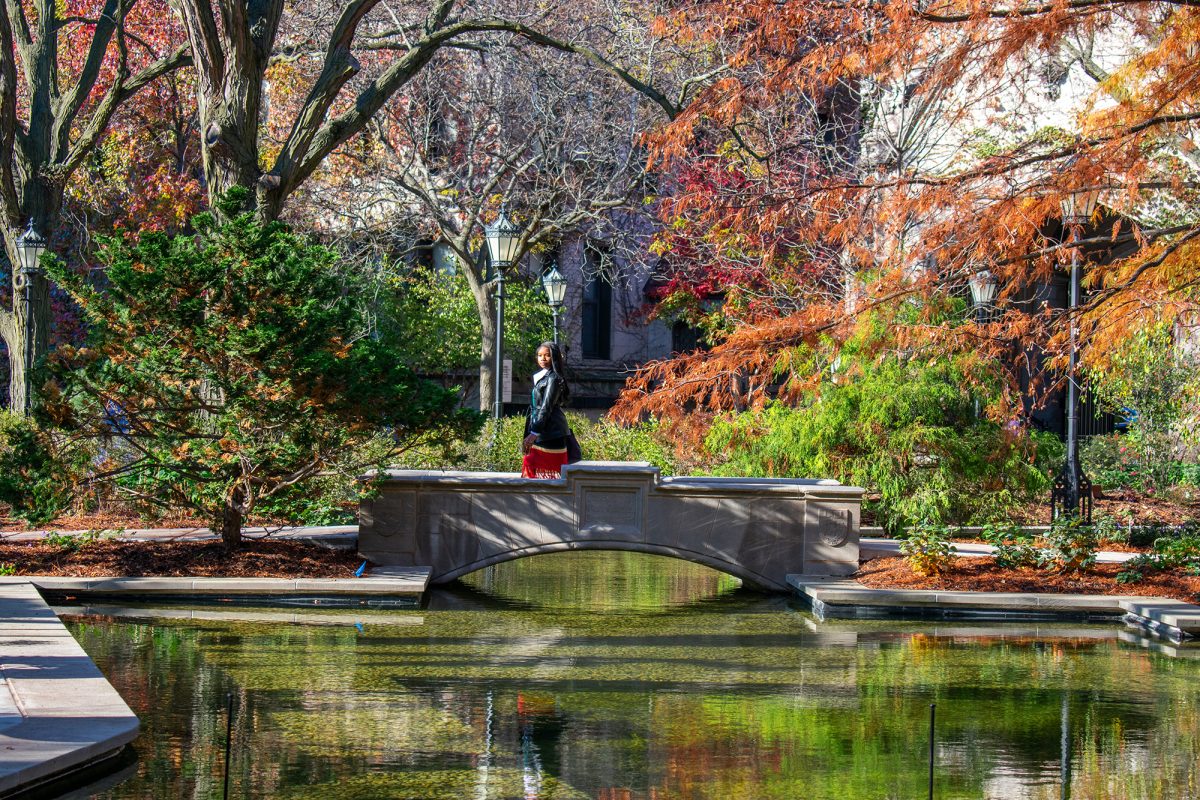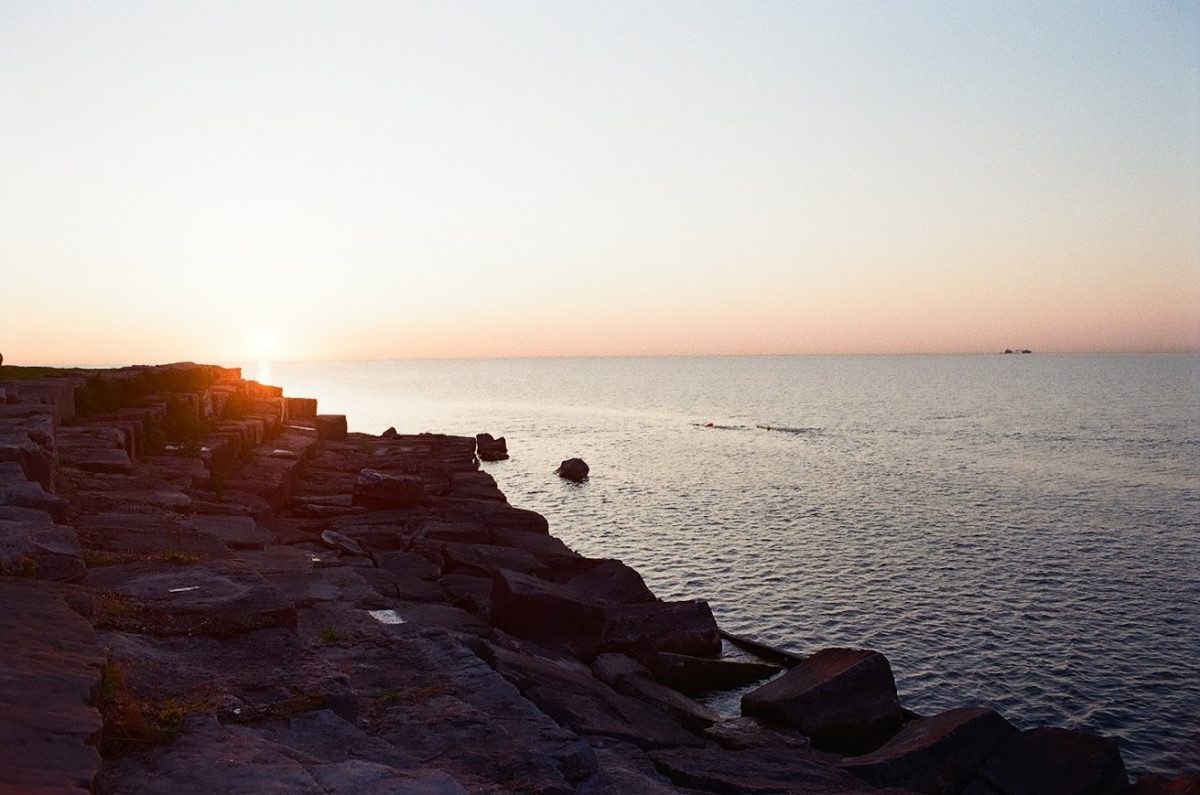December 2, 1942: Beneath the stands at Stagg Field, something fundamental about mankind changes. Enrico Fermi’s calculations are correct, and Leo Szilard’s design works. The towering stack of graphite and uranium contains the first artificial self-sustaining nuclear chain reaction. We now have access to the indescribable power of the atom.
Innumerable changes have taken place since that day, in and out of the University. On the eastern side of South Ellis Avenue, Max Palevsky residence hall now houses many of the University’s students. Next door, where Stagg Field once was, Regenstein and Mansueto Libraries bustle with activity. But between the orange facade and the futuristic dome, where the stacks of graphite and uranium once stood, sits a curious brazen form. Its smooth rounded top emerges from a twist of metal. Its core is hollow. On the platform which raises the statue from the sidewalk, rays propagate out from the center. A plaque a few yards away informs passersby that the structure is a memorial to Chicago Pile-1, the beginning of the Atomic Age.
August 6, 1945: The underside of a Boeing B-29 Superfortress, Enola Gay, opens over the Japanese city of Hiroshima. It releases a single bomb, called Little Boy, which explodes over Shima Hospital. Conservative estimates say that America’s first use of the atomic bomb kills 80,000 people instantly. Three days later Bockscar drops a second bomb, Fat Man, on Nagasaki, killing at least 35,000 people.
Professor Henry Frisch works in the Physics Research Center, located across the street from the memorial. His father, David Frisch, worked on the Manhattan Project at Los Alamos, where the seed formed under Stagg Field first began to sprout.
Fat Man used plutonium and was a more precise device than the simpler Little Boy, which used uranium. Henry Frisch said that “a good high school kid could build a Hiroshima bomb in his garage in a weekend.” That is, if they managed to obtain enough uranium-235, the particular isotope used in Little Boy.
Dieter Gruen, who previously worked at the material sciences division of the Argonne National Laboratory and helped create the uranium for Little Boy at the Oak Ridge National Laboratory, told The Maroon that “in September of 1944…there was not a gram of uranium-235 to be found.” By April of 1945, Gruen and the other scientists at Oak Ridge had separated “more than 50 kilograms of uranium-235, which made its way into the Hiroshima bomb.”
Gruen arrived in America in 1937, a refugee from the Nazi regime. He studied at Northwestern, then earned his Ph.D. from the University of Chicago. Before he came to the University of Chicago, he worked on the Manhattan Project. The University of Chicago had completed its role in the Manhattan Project by 1944, and there was no more work to be done in the city where Gruen studied.
“But the project at Oak Ridge, the separation of uranium-235,” he said, “was very much in need of scientific manpower, so I went down there.”
Although he had helped make Little Boy’s material, Gruen heard about the bombings of Japan at the same time everyone else did.
“I expected it would be used,” he said, “but I had no conception of the destruction that it caused.”
Gruen and his colleagues, he said, were immediately convinced that the atomic bomb should never be used again.
March 1, 1954: A device housed in a long metal cylinder and watched by innumerable scientific instruments sits on an artificial island at Bikini Atoll. The Castle Bravo nuclear weapons test begins, and the device, a newly designed thermonuclear bomb, detonates. Its flash turns the sky white and boils the sea. As the light dies away, rings drift into the sky. The bomb exploded with the force of 15 megatons of TNT—more than twice as strong as the six megatons predicted. Its fallout goes farther than predicted. It poisons more people than predicted.
This generation, Gruen emphasized, “has to become aware of that fact that the arsenals today are not Hiroshima bombs, but they are bombs that are a thousand times more destructive. A hydrogen bomb today would destroy not a city the size of Hiroshima, but a city the size of Chicago. It would not kill 100,000 people, but 10 million people.”
In 1947, the recently founded Bulletin of Atomic Scientists published their Doomsday Clock as a measure of how close the world is to the “midnight” of apocalypse. In its first appearance, it was set at seven minutes to midnight. Since then, it has ticked back and forth, keeping pace with developments in the technology and politics of nuclear energy.
January 1, 1946: The Atomic Energy Act of 1946 goes into effect. Section 10: “Control of Information” states that new nuclear developments shall be born secret and shall remain secret until explicitly declassified.
Professor Jessica Hurley, a literary scholar who studies the nuclear-military-industrial complex, told The Maroon that the act constituted “the biggest shift in the nature of democracy this country has seen.”
Hurley catalogued the ways nuclear technology has affected the world around us.
“It’s the largest national project in American history, not only the Manhattan Project, but also every year since then,” she said. “It has completely transformed our legal system, our democratic structure, the way that business operates, the way that our cities are laid out.”
The secrecy around nuclear weapons, she said, “also meant that everyone who worked anywhere near it needed security clearance, which obviously opens up people's lives to a whole lot of government surveillance.”
“In an abstract sense,” Hurley said, “I can think about little that is less democratic than having a situation where one person with their finger on a button can kill everyone on the planet, without consultation, without even congressional approval.”
Hurley also referenced how some groups, like Native American communities, are more vulnerable to nuclear exposure than others. “People are being killed by this every day, and we don’t see it if we don’t think of it as something that is ongoing and happening now,” she declared.
December 8, 1953: President Dwight Eisenhower gives his “Atoms for Peace” speech before the U.N. General Assembly. He acknowledges the horror of nuclear weapons, but proposes that unfinished nuclear technologies could improve life.
That same year, to account for the invention of the hydrogen bomb, The Bulletin of Atomic Scientists moved the minute hand of the Doomsday Clock forward to two minutes to midnight.
In 1954, an amendment to the Atomic Energy Act made commercial nuclear reactors legal for the purpose of producing electrical energy. Nuclear reactors improved little by little and slowly appeared around the country. Gruen pointed out that despite electrical generation ostensibly being a peaceful use of nuclear technology, the products of the nuclear plants still pose an inherent threat.
“Nuclear reactors produce plutonium, which is a bomb material, so there is always danger that the plutonium, when it is produced, will be diverted from peaceful uses to nuclear weapons,” he said.
Gruen explained that a reactor designed at Oak Ridge in 1956 demonstrated a design safer that the technology in service even today. But “that reactor was built and operated in the mid-sixties, and then it no longer received funding and was shut down.”
Gruen also “worked in problems related to fusion for 20 years.” Fusion could imaginably lead us into a world of clean atomic power. “But to do fusion energy here on earth,” Gruen said, “requires that we duplicate the conditions that exist in the center of the sun, here on earth. And that creates enormous technical problems.”
Hurley questioned the promise of Eisenhower’s “Atoms for Peace” speech, claiming that it projected an ultimately illusory image of a peaceful and safe atomic future. She believes it was an intentional attempt to divert international attention away from the destructive possibilities of nuclear weapons.
In 1953, the Doomsday Clock read two minutes to midnight, and, in Hurley’s words, “everyone else on the planet was like ‘Americans are barbarous mass murders, warlords! What are they doing, building up this giant nuclear arsenal?’”
So America, Hurley said, started to paint pictures of possibilities. However, the peaceful technologies didn’t exist yet, weren’t safe, or weren’t cost effective. “But it is an extraordinarily effective PR campaign, because it does a really good job of changing people’s connotations around atomic energy,” she said.
Remembering the Cuban Missile Crisis, Frisch recalled that “we came very, very close to losing it all. I don’t think people understand…how easy it is to lose it all.”
Following the introduction of still more powerful nuclear technology, the world was in a new and precarious situation. At any moment, a single flash could wipe out every major city. But in 1963, in fresh memory of the Cuban Missile Crisis and Castle Bravo, the Partial Test Ban Treaty was put into effect, banning all but underground nuclear tests.
So the Doomsday Clock ticked backward to 12 minutes to midnight.
December, 1967: In the 25 years since CP-1, the old Stagg Field has been razed, though Regenstein Library has yet to be built. A curious brazen form, titled “Nuclear Energy” by its creator, British artist Henry Moore, is unveiled to the public at the University of Chicago.
The University had been considering an anniversary memorial since the early ’60s. Eventually, they settled on a statue. They commissioned Henry Moore because he had offered to take on the project without contract, or even without certain payment.
Moore said that to him, the curved top of the statue recalled the mushroom cloud of a bomb, the destructive side of nuclear technology. The lower half was comfortingly structural, “more an architectural cathedral.” It represented productive nuclear technology, Eisenhower’s focus in “Atoms for Peace.”
To Gruen, the statue brings to mind his conviction against nuclear atrocity.
Hurley said that the statue reminds her of Maya Lin’s stark black Vietnam Veterans Memorial in D.C. But she said she doesn’t see “Nuclear Energy” as carrying quite as powerful a warning.
Frisch has heard critics’ questions: “Is it a skull? Is it a nuclear explosion? Death’s head? What is it?” In his mind, “the answer is probably all of the above.” And yet, his memories lend it a lighter cast.
“My own personal association,” he said, “is that we had little kids and they loved to slide down the middle of it—it’s a perfect slide.”
Despite general scientific consensus that the Three Mile Island accident in 1979, the result of a mechanical failure in Pennsylvania that led to a partial release of radioactive material, did not cause a significant increase in the area’s cancer rates, it shocked Americans into anti-nuclear advocacy. Major protests against nuclear power plants and nuclear weapons swayed public opinion and influenced politics and business. Many Americans began to distrust all nuclear technology. Gruen pointed out that “there is no nuclear reactor [that has] been built for power production in the United States for 40 years, not since Three Mile Island.” For Hurley, nuclear accidents aren’t a matter of if, but of when.
In the early ’90s, with the 50th anniversary of Fermi’s experiment approaching, Frisch had an idea.
“I proposed,” he said, that the University of Chicago “assemble the heads of state of the nuclear states, and have each one discuss how we made it through 50 years.” He wanted the university where the Atomic Age began to host a series of speeches, so that leaders could tell the world “what they proposed to make it more likely to get through the next 50.”
Reception to the plan was warm at first, but cooled rapidly.
“The physics department was sort of stunned by it,” he said. “But after discussion [they] liked it, so they forwarded it to the dean, who also the initial reaction was no, but then they thought about it. It went all the way up to Hanna Gray and we got back a single word answer, ‘no.’ There was no explanation, there was no discussion.”
Frisch pointed out that since he proposed his conference plan, Pakistan and North Korea have developed bombs. The United States, Russia, China, France, United Kingdom, India, and perhaps Israel still have theirs.
December, 2017: The University of Chicago holds a series of events to commemorate the 75th anniversary of the experiment that took place on its grounds, including speeches by field leaders and panelists before packed auditoriums. Artist Cai Guo-Qiang sets off pyrotechnics from the roof of Regenstein Library, briefly erecting a multicolored mushroom cloud over the campus, for all to see and hear.
Students laid silently on the steps of Henry Moore’s “Nuclear Energy” while the colorful cloud rose above them in what Hurley called “a die-in.” The event’s own organizer, fourth-year India Weston, proposed it as a “productive and meaningful peripheral event” to remind attendees that radiation does not vanish as quickly as a pyrotechnic cloud. She returned this year, painting temporary shadows on the statue’s pedestal in an effort to continue “critical dialogue about nuclear weapons and nuclear energy.”
“Look up and see the festive mushroom cloud,” Hurley said, “and then look down and students are challenging you with the reality of what it actually did. That to me captured something really powerful.”
In 2018, the Doomsday Clock is at two minutes to midnight, the closest it to midnight has been since 1953. The Bulletin of Atomic Scientists stated that they moved the clock 30 seconds forward from 2017 due to “the failure of President Trump and other world leaders to deal with looming threats of nuclear war and climate change”—two perennial, not unrelated problems that threaten to end life as humans know it on earth.
Hurley explained some of the links she sees between nuclear technology and climate change and pollution. She pointed out the contamination of the Hanford Site in Washington state. She also claimed that government actions to turn contaminated land into “nature reserves” or to compare nuclear technology to fossil fuels are part of an attempt at “greenwashing.” “Greenwashing,” as she defines it, “is when you make something look environmentally friendly to disguise all of its other bad parts.”
Reminiscing on the Cold War, Frisch said, “Those were scary times. They are scary times now, except that people sort of have forgotten.” Gruen echoed his concern: “Very few people have ever seen what destruction can be caused, and if you had a global nuclear war today, it is entirely likely that it would destroy all of civilization.” Our generation must look back at history, before, in our blindness, we repeat it.
Frisch worries about nuclear proliferation, and the ease with which rogue groups could construct a bomb with stolen material.
Gruen is working on solar power, hoping to head off climate change with a less dangerous tool. “The current situation doesn’t look very encouraging,” he said, “but who knows. I have myself decided that what we need to do as a society and as a world is to concentrate on solar power, so I have spent the last six years of my life developing a new concept for making cheap solar electricity.”
Hurley sees two futures. Perhaps, “civil society continues its slow crumble until it becomes incapable of upkeeping the nuclear infrastructures it has built, and we just get more and more low grade nuclear disasters, more and more Chernobyls, more and more sites like Hanford.” Humanity would fade out, experiencing a “slow worsening, and immiseration, and an increasingly radioactive and toxic world.”
Or perhaps, as in Hurley’s second future, “communities all over the world will decide that actually they don’t want to live in this immiserated situation, under the threat of horrifying death at every minute. They will organize and take apart the nuclear complex bit by bit, and figure out how to store it in a way that actually promotes human life and human dignity and human values and environmental safe keeping for all beings.”








